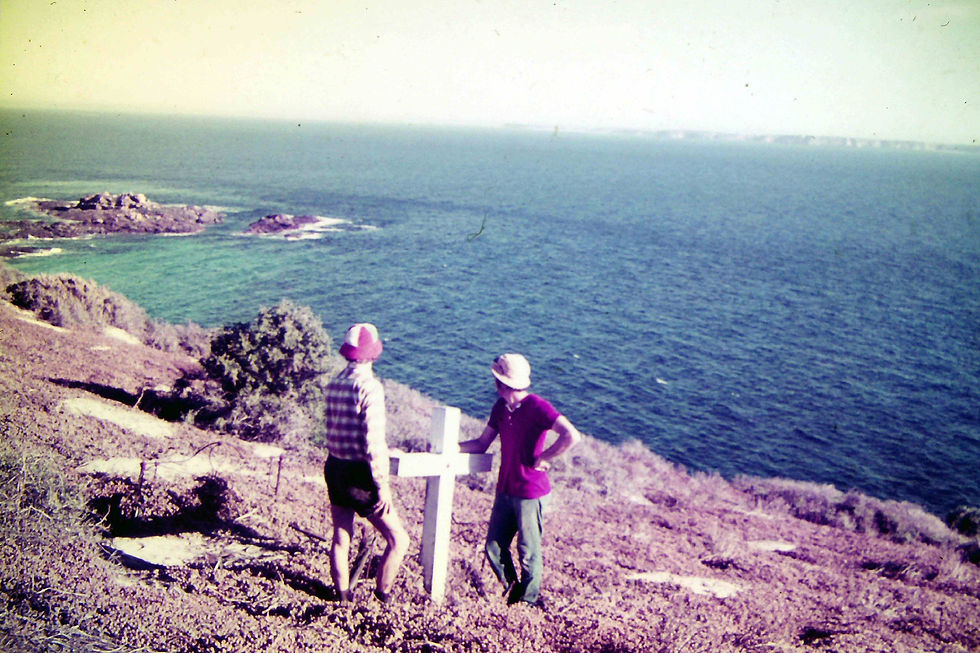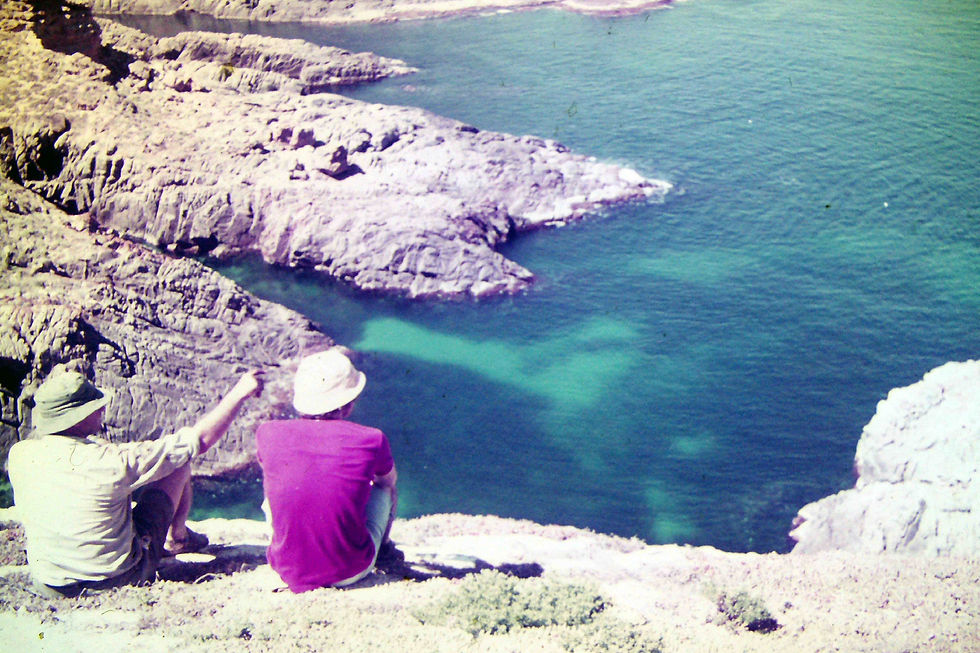The Graves at Althorpe Island
- Steve Reynolds
- Dec 22, 2024
- 4 min read
Updated: Dec 26, 2024
It appears that Doug Seton took a series of slides at Althorpe Island many years ago. This slide appears to be of the Althorpe Island lighthouse: -

This is a Google map showing Althorpe Island: -

This photo from The Advertiser of 19th January 2005 shows the "View of Althorpe Island from Cape Spencer lighthouse on the Yorke Peninsula.": -

This slide of Doug's appears to be of some of the the graves to be found on Althorpe Island: -

This is a Google map showing the location of the graves on Althorpe Island: -

The graves are near the Althorpe Island jetty. You may just be able to distinguish a white cross just below the centre of the above photo.
According to “The Jetties of South Australia Past and Present” by Neville Collins, the jetty was built in 1878.
According to https://collections.slsa.sa.gov.au/resource/PRG%20280/1/6/466 , this photo shows “A wooden memorial inscribed to the memory of 'G. Peterson aged 58 years died October 8th 1838' installed at the head of a grave on Althorpe Island, South Australia.”: -

A grave on Althorpe Island [PRG 280/1/6/466] - Part of Searcy Collection
(Source: State Library of South Australia)
According to the Friends of Althorpe Island Conservation Park’s Facebook page, “South Australia's 2nd oldest known grave. G. Peterson is known to have been a Norwegian Whaler, buried on Althorpe Island 2 years after colonial...
According to https://friendsofparkssa.org.au/members/members-directory/friends-of-althorpe-islands-conservation-park/ , there are “four graves: (1)1838,(whaler) (2)1890, (Guano Mining) (3)1919, (steam driven ship, (4)SA’s 14th worst shipwreck disaster) 1937, fatality of the fishing industry. (All representing social and economic eras.)”
This is a photo of the grave of Julie Garbis (the 1890 Guano Mining grave): -

According to https://friendsofparkssa.org.au/wp-content/uploads/2021/03/FoAICP-FINAL-Feb21Newsletter.pdf the culturally significant graves, which date back to 1838, 1919 and 1937.
According to https://collections.slsa.sa.gov.au/resource/PRG+280/1/19/152 , this is a photo of “A grave memorial to three crewmen of the S.S.'Paneora' (PAREORA) which was wrecked on Althorpe Island in Investigator Strait, South Australia.”

1919 : (PRG-280-1-19-152 : State Library of South Australia) Part of Searcy Collection
According to “South Australia’s Shipwrecks – A Data Base 1802-1989” by Peter Christopher, the SS Pareaora was wrecked at a reef north of Althorpe Island on 18th September 1919.
According to https://monumentaustralia.org.au/themes/disaster/maritime/display/50366-%22ss-pareora%22 , “SS Pareora - The cross, erected at the gravesite, is a memorial to three crewmen of the "S.S. Pareora" which was wrecked in 1919 on Althorpe Island in Investigator Strait, South Australia.
"On Wednesday morning 17-September 1919, SS Pareora departed Port Pirie with a cargo at zinc concentrate for the company's works at Risdon near Hobart. During the early hours of 18 September 1919 the vessel struck an outlying rock off the north side of Althorpe Island. the crew tried unsuccessfully to release the lifeboats, and the weather deteriorated. The steamer was struck by a large wave that filled the engine room and washed the boats overboard. The force of another wave sheared off the stern and pushed the remaining part of the vessel onto its side. Four of the crew attempted to swim to shore but were not seen again. The rest of the crew clung to the wreck, with successive waves washing individuals overboard. Eventually, after two hours, the bridge was swept away and the Pareora turned over and slid beneath the water. Three of the surviving crew were swept towards the cutter Zephyr, which was sheltering about a quarter of a mile away. They roused the master and crew, who bravely took the cutter out into the storm to rescue other survivors.
"In total, eleven lives were lost in this tragedy, but only three bodies were recovered. The Marine Board enquiry was inconclusive, but attributed the Pareora’s grounding to ‘faulty navigation’.
"Lying forlornly on a slight rise near the Jetty, where the shadow of the cliff seems to cover it like a shroud, is a grave, containing the remains of the three men who were washed ashore from the ill-fated Pareora. The grave is surrounded by a white-painted fence, and set in the middle, is a cross. bearing an inscription:—"ln memory of J. C. Branthwaite, J. P. Booth, R. Doerly, S.S. Pareora, 18/9/19." The grave is kept painted by the lighthouse keepers."
(The Advertiser (Adelaide, SA), 3 March 1934.)
According to https://www.environment.sa.gov.au/topics/heritage/maritime-heritage/visiting-maritime-heritage-places/shipwreck-trails/investigator-strait , “SS Pareora (1896-1919), Investigator Strait Shipwreck Trail, Location: Althorpe Island, northern side (-35.362455°S 136.857775°E)
Vessel type: steel-hulled screw steamer
SS Pareora was built in Newcastle-Upon-Tyne, England, in 1896. Pareora left Port Pirie for Hobart on 16 September 1919 with a 672-tonne cargo of zinc. At 4am on 18 September the Pareora, in heavy seas, struck rocks to the north of Althorpe Island near The Monument rock. The tremendous power of the waves quickly broke the vessel, shearing off the stern section. Unable to release the lifeboats, the crew either jumped or were washed overboard. Of the 18 members of the crew, 11 drowned, including Captain J.C. Macfarlane.
Today, a large proportion of the wreck, including a boiler, steel frames and hull plating, as well as the engine, can be found lying in a gully between two reefs. The remains of the bow structures and machinery lie in an adjacent gully about 30m to the east, and include an anchor, hawse pipes and windlass.”
That web page features this photo of the wreck: -

The late Jack Loney's book "Wrecks on the South Australian Coast" describes the wrecking of the Pareoa thus:
"grazed a reef about a kilometre wets of the islands before striking a rock known locally as The Monument, and was swept by heavy seas and broke up quickly."
This MAY be another of Doug's slides from Althorpe Island, and there may be others, but there is no certaintly about this: -

This is a Google shot of the Althorpe Island lighthouse and the row of cottages mentioned by Neville Collins in “The Jetties of South Australia Past and Present”: -





Comments